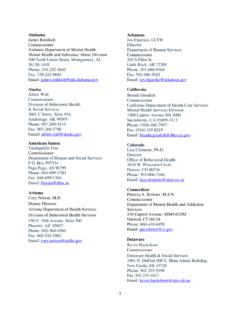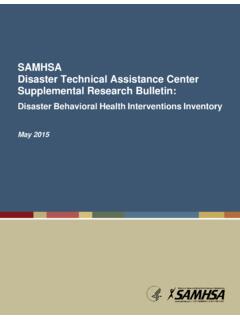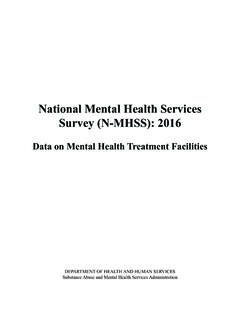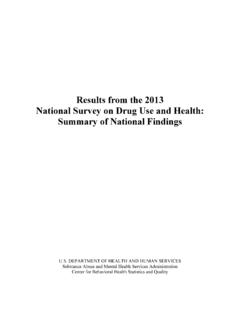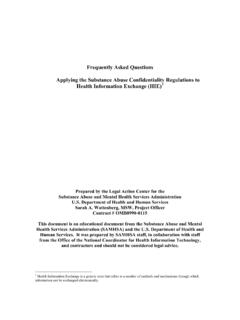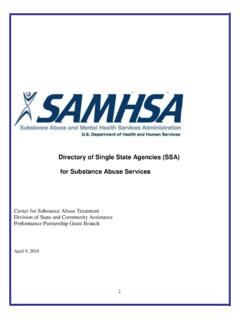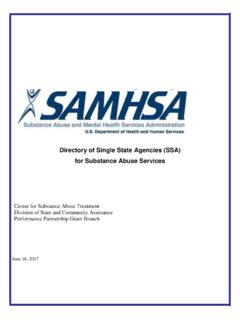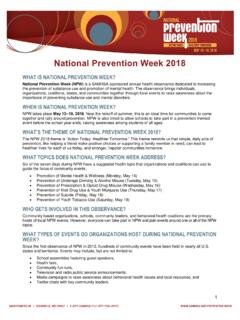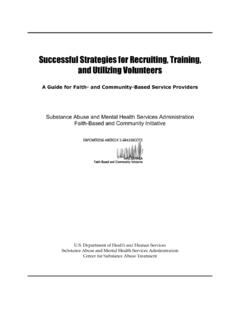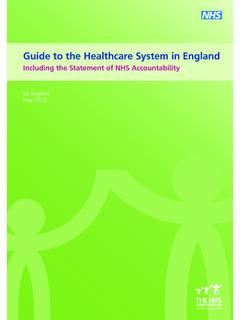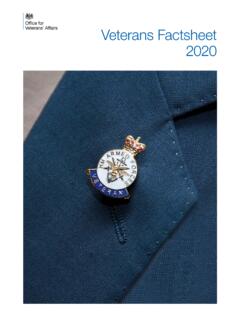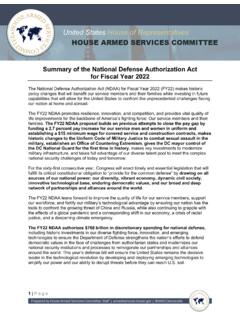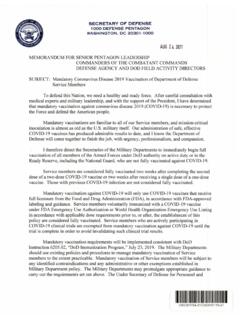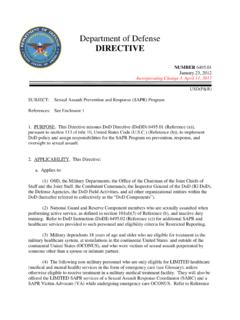Transcription of Understanding the Military: The Institution, the Culture ...
1 2010. Working Draft Understanding the military : The Institution, the Culture , and the People Working Draft Acknowledgement The author would like to thank Pam Woll of Human Priorities for her invaluable assistance in the creation of this document, and specifically for the development of the list of clinical implications found in the appendix. Disclaimer The opinions expressed herein are the views of the author and do not reflect the official position of CSAT, SAMHSA, or DHHS. No official support or endorsement by CSAT, SAMHSA, or DHHS for the expressed opinions herein is intended or should be inferred. This document was authored by Angela Halvorson, TopLine Professional Strategies, a consultant of Abt Associates under the direction of Melanie Whitter, for the Substance Abuse and Mental Health Services Administration's (SAMHSA) Center for Substance Abuse Treatment (CSAT) Partners for Recovery Initiative.
2 Shannon B. Taitt, , served as the Government Project Officer. Understanding the military : The Institution, the Culture , and the People Working Draft Table of Contents Introduction .. 1. armed forces : The Institution .. 1. The Structure .. 1. Budget .. 2. Branches of Service .. 2. Components .. 2. The Active Component .. 2. The 3. National 4. The Reserves and National Guard in OIF and OEF .. 5. military Ranks and Chain of 6. The Chain of Command .. 7. military Values .. 9. Leave No One Behind .. 9. military Culture .. 10. armed forces : The People .. 11. Personnel Numbers and Stationing .. 11. Women in the military .. 12. Sexual Harassment/Assault .. 13. Demographics .. 13. Age .. 14. Race/Ethnicity .. 14. Education Level.
3 14. Socioeconomic 15. Marital Status .. 15. i Understanding the military : The Institution, the Culture , and the People Working Draft The military Family .. 15. Deployments .. 16. The Experience of War .. 19. Physical Aspects of War .. 19. Mental and Emotional Aspects of War .. 19. Reunion and Reintegration .. 20. Clinical Implications .. 23. Conclusion .. 24. Appendix .. 25. Challenges and Implications for Behavioral Healthcare Services .. 26. military Ranks .. 32. ii Understanding the military : The Institution, the Culture , and the People Working Draft Introduction The armed forces are highly trained and ready to respond at a moment's notice to natural or human-made disasters anywhere in the country or the world. Yet many Americans'.
4 Knowledge about the military is limited to what they have acquired from movies, books, and news reports. Few outside the military understand the Culture , the values, or the people who make up the most powerful military force on earth. What do people see in the armed forces that makes them dedicate their lives, and their families' lives, to military service? What is the military and who are the people who fill its ranks? How have the wars in Iraq and Afghanistan affected today's armed forces ? What does this mean for the helping professionals who would serve them after they return from deployment? This paper is designed to answer some of these questions by providing an overview of the military as an institution, the service members and their families who are the backbone of the institution, and how current military conflicts have affected service members, their families, and the future of military service.
5 The information contained herein is not an exhaustive overview of military Culture but provides civilians, specifically behavioral healthcare specialists working with military personnel, with a basic Understanding of the unique life and Culture that is the military . armed forces : The Institution Like any large organization with a well-established history, the armed forces has its own Culture , language, and ways of conducting business. For civilians with little or no personal exposure to the military Culture , the armed forces may seem overwhelming, incomprehensible, esoteric, or even anachronistic. However, to understand, work with, and help those who serve in the armed forces , it is necessary to have a general Understanding of the institution.
6 The Structure The military is civilian controlled, and the ultimate authority is the President of the United States, who serves as the armed forces ' Commander in Chief, in a civilian rather than a military capacity. This power is vested in him or her through Article II of the Constitution; Article I. of the Constitution, however, gives the Congress the power to declare war. This is a purposeful separation of powers instituted by the Founding Fathers that underscored a fear of large standing armies and their potential to impede a free and democratic society. The military is an agency of the Government, whose role it is to implement the policies set by Congress and the Commander in Chief. The Secretary of Defense (SecDef), a cabinet-level position, is the principal defense policy advisor to the President and is responsible for the 1 Understanding the military : The Institution, the Culture , and the People Working Draft formulation of general defense policy and policy related to all matters of direct and primary concern to the DoD [Department of Defense] and for the execution of approved policy.
7 Under the direction of the President, the Secretary exercises authority, direction, and control over the Department of Defense. 1 The DoD is the primary tenant agency inside the Pentagon and is responsible for providing the military forces needed to deter war and protect the security of the United States. 2 The SecDef serves as second in command of the armed forces under the President. Next in the chain of command are the combatant commanders, of which there are 10 around the globe, each responsible for either a geographic area or specialized mission. The Chairman of the Joint Chiefs of Staff and the Service Chiefs of Staff are responsible for the readiness of the five branches of the armed forces and serve as the President's military advisors but do not serve in any military chain of command.
8 Budget The United States has the largest defense budget in the world. In 2010, more than $550 billion was appropriated for the Department of Defense, more than a 75 percent increase over 2001. appropriations. The large increase in defense appropriations is due primarily to the cost of manning, training, and equipping two fighting forces one in Iraq and one in Afghanistan. An additional $130 billion was appropriated for Overseas Contingency Operations. An average of an additional $200 billion was appropriated for other defense-related spending that includes funding for the Department of Veterans Affairs, Homeland Security, and the State Department. 3. Branches of Service There are five branches of the military the Army, Navy, Marine Corps, Air force , and Coast Guard under three primary military departments: the Department of the Army, the Department of the Navy, and the Department of the Air force .
9 The Marine Corps is permanently within the Department of the Navy, while the Coast Guard falls under the authority of the Department of the Navy in wartime and under the Department of Homeland Security in times of peace. However, the Coast Guard is always considered one of the five branches of military service. Components Within the five services are two distinct components: the reserve component and the active component. The Active Component The active component is composed of full-time service members. These are the individuals who wear the uniform every day and are stationed all over the world, in both combat and 1. 2. Ibid. 3. #budget. 2 Understanding the military : The Institution, the Culture , and the People Working Draft noncombat situations.
10 Active component service members and their families live on or near military posts or bases and are essentially transient, expecting to move every three to five years, a circumstance virtually unheard of in the civilian workforce. Duty locations are determined by the needs of the armed forces and the military qualifications of the service member. When they are not in combat, active component service members spend their days training for combat. Training takes place at their home station or at any number of training locations around the world. It is not unusual for an active component member to spend only one or two weeks at home out of every six to eight weeks. Training cycles are determined by their unit's deployment cycle and deployment schedule.
